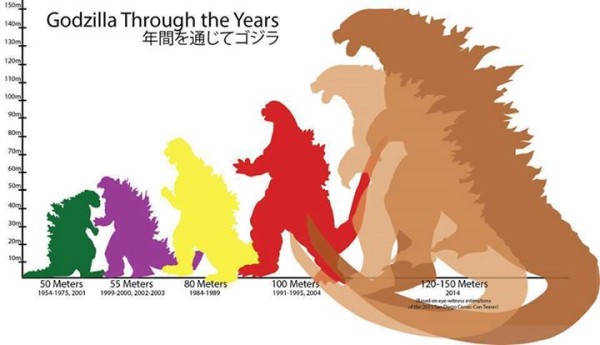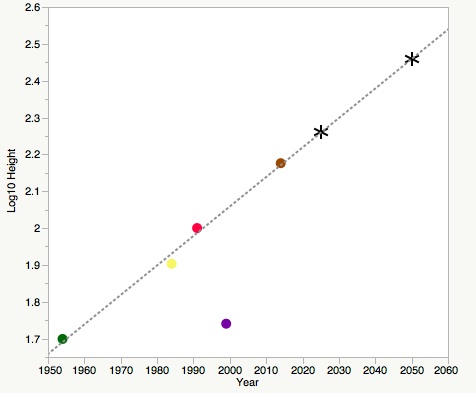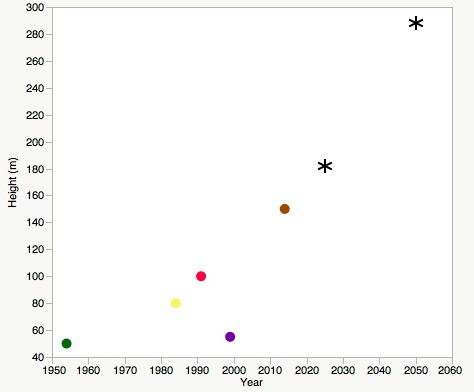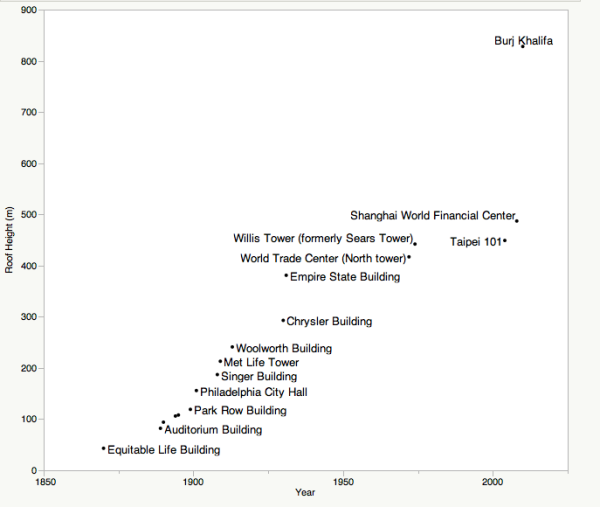 In 1954 Godzilla was a mere 50 meters (164 ft). In the newest movie, Godzilla is estimated to be 150 meters (492 ft). For comparison the Empire State Building in New York City stands at 381 meters (1250 ft). Incarnations of Godzilla went from 13% of the height of the Empire State Building to nearly 40% of the height in just 60 years. It took cetaceans 55 million years to go from 2.5 meters (8.2 ft) to 30 meters (98 ft) in length.
In 1954 Godzilla was a mere 50 meters (164 ft). In the newest movie, Godzilla is estimated to be 150 meters (492 ft). For comparison the Empire State Building in New York City stands at 381 meters (1250 ft). Incarnations of Godzilla went from 13% of the height of the Empire State Building to nearly 40% of the height in just 60 years. It took cetaceans 55 million years to go from 2.5 meters (8.2 ft) to 30 meters (98 ft) in length.
This increase in size within a group animals through time, i.e. larger species and larger species are constantly showing up on the evolutionary state, is a well known rule of biology. We refer to this pattern as Cope’s Rule, named after an American paleontologist Edward Drinker Cope. At broad levels, Cope’s Rule is definitely true. The start of life on this planet was microscopic and now we have whales and redwoods. However, a mixed bag of patterns of increasing, decreasing, and no change is body size is seen in organism as diverse as molluscs and mammals. Even within a single group like mammals, some groups like rodents show little change with time, while whales get larger with time, and horses get both bigger and smaller.
![]() Godzilla appears to be following Cope’s Rule. So how big will Godzilla be in 2050? Rhett Allain at Dot Physics calculates this to be 170 meters. But I, as nerds debating meaningless things will, disagree. Allain appears to use multiple dates for each iteration of Godzilla. For example, the 50 meter Godzilla occurs in movies from 1954-1975 and again in 2001. In Allain’s plots, 50 meter Godzilla occurs in 1954, 1960, 1970, and 1991. This artificially weights the analysis and treats separate iterations, i.e. species, of Godzilla the same as a single individual of the same species of Godzilla. To restate, different sightings, e.g. different movies, of the same individual of Godzilla are put into the analysis multiple times even though they are presumably the same individual. I prefer to use a standard paleontological method, specifically the size at first occurrence.
Godzilla appears to be following Cope’s Rule. So how big will Godzilla be in 2050? Rhett Allain at Dot Physics calculates this to be 170 meters. But I, as nerds debating meaningless things will, disagree. Allain appears to use multiple dates for each iteration of Godzilla. For example, the 50 meter Godzilla occurs in movies from 1954-1975 and again in 2001. In Allain’s plots, 50 meter Godzilla occurs in 1954, 1960, 1970, and 1991. This artificially weights the analysis and treats separate iterations, i.e. species, of Godzilla the same as a single individual of the same species of Godzilla. To restate, different sightings, e.g. different movies, of the same individual of Godzilla are put into the analysis multiple times even though they are presumably the same individual. I prefer to use a standard paleontological method, specifically the size at first occurrence.

So redoing the analysis, I first find no actual statistical increase in size with time. That is because the second smallest Godzilla, 55 meters, did not appear until 1999 (purple dot in the graph), the regression between size and time is not significant with this point included. I am also not sure why the artist of the plot decided to place the 55 meter purple Godzilla out of temporal order. If purple Godzilla is thrown out of the analysis we get the equation
Log 10 Height = -13.94 + 0.008 Year
So in 2050, I calculate that Godzilla would be 288.4 meters not 170 meters.

So why is Godzilla obtaining ever larger sizes with time? Skyscrapers. Skyscraper height has increased dramatically over the last century. For Godzilla to continue to plow through buildings in major metropolises, a more formidable size is needed. Of course this size change can only be evolutionarily adaptive if it changes the fitness of Godzilla, i.e. in the simplest case the number of offspring passed to the next generation. If Godzilla is able to topple buildings this might allow for greater acquisition of resources in this case food in the form of people. This would increase the lifespan of Godzilla allow for more reproduction or allow for greater amount of energy to be passed to the offspring increasing their rate of survival Or perhaps toppling buildings is a sexual display that sexual partners cue on. Sexual selection!
Of course the real problem of a 55,000 ton Godzilla is the urine production. Using the handy Kaiju post, we can quickly calculate that, 151,436,928 12,921,400 gallons per day. That is about 1.8 about quarter of the hold of the largest production oil tankers.

Share the post "The Ever Increasing Size of Godzilla: Implications for Sexual Selection and Urine Production"






So if Godzilla produces 151,436,928 gallons of urine per day, how long would it take to completely destroy the ecosystem of Earth due to his radioactive Urine?
Great article, but I have to disagree with the urine production.
Assuming metric ton(ne)s, Godzilla in his latest iteration weighs 55,000,000kg. At 3.78l per gallon, the figure above equals 572,431,587.84l of urine per day. I’ve never weighed urine, but I know that a lire of water equals one kg; I can only assume that urine, being made up of water, minerals and waste products must weigh minutely more, so we’re looking at over 572 million kgs, or over 10X body mass.
I’m no scientist, but I do urinate. I weigh 180lbs and I can guarantee that, even over the course of a night of heavy beer consumption and the following day of water-fuelled recovery – again, I’m no scientist, but I was a student – I’ve never urinated to the tune of 10X my body mass.
Still, an entertaining read. Cheers!
Arthur,
Somewhere my calculations got off. Went back and recaculated. See the estimates above. Nice catch.
Would it not be an important distinction to make that lizards, like birds, do not urinate in the “wet stream” sense, rather they excrete uric acid from their bowels, hence the white powdery substance found in droppings?
Perhaps what we get when Godzilla pees is instead a radioactive, acidic hot sludge. The fiction writers of this genre could have a field day with this novel substance.
I’d love to see a chart comparing Godzilla sizes to average building size of the time.
“If Godzilla is able to topple buildings this might allow for greater acquisition of resources in this case food in the form of people.”
The problem is, Godzilla doesn’t eat people, so that can’t play into the theory. Second, even if an argument could be made for the occasional jet fighter to the mouth or the sacrifices offered in the 1950s (which didn’t prove the monster’s consumption of said sacrifices), humans are an inefficient source of nutrition for a monster 50m tall, much less 150 or more. Besides, the movie history has indicated that there is a radioacitve source of energy that powers him.
Still, thanks for an entertaining analysis!
In the grand tradition of obsessive nerds, I am curious where you got the estimate of 150 meters for Godzilla’s height. Everything I’ve seen (including comments from the director) has Godzilla at 350 feet tall, which is around 106 meters or so.
Still off. You used the figures for frogs. Godzilla appears to be much closer to a lizard. Frogs produce large quantities of dilute urine, whereas lizards do not (note the frog rate being nearly 1000 times that of the mammalian rate). Using the figures for mammals is probably closer. With that 55k tons for Godzilla divided by the 6750 tons for Slattern multiplied by the mammalian urine production rate of ~2k gallons, we get a much more reasonable 16000 gallons of urine a day. That would fill an olympic swimming pool to a depth of a measly 2 inches. Enough to put out a building that’s on fire, but nobody’s going to drown in it.
Urine is good for tanning hides.
I wonder how many cowboy boots you could make out of Godzilla?
As I recall, Hanna Barbara’s Godzilla cartoon had him pegged at 300′.
From the lyrics of the theme song:
“Up from the depths
Thirty stories high
Breathing fire
His head in the sky
Godzilla!
Godzilla!
Godzilla!
And Godzookie…”
May not be canon, though.
The Journal of Irreproducible Results / Ignatius Nobel Prize awaits . . .
I assumed that Godzilla was closer to a frog spending part of its life in aquatic environments thus allowing for the possibility of a dilute urine. If Godzilla is closer to a mammal the figure would be 9,485.11
True about reptiles in general but note that aquatic reptiles like Crocodilians do produce urine.
See the chart at the top.
I must correct an error in the article. It says, “If Godzilla is able to topple buildings this might allow for greater acquisition of resources in this case food in the form of people.”
Incorrect! In none of the Godzilla movies does Godzilla ever eat anybody, and it certainly isn’t for lack of opportunity. Whatever form his food may take, it ain’t people.
I was about to wonder how the hell it could drink that much water to flush itself at the higher volume. I also assume it mostly drinks salt water. I just can’t see godzilla stopping to drain a fire hydrant for 2 hours a day being super efficient. Especially when the system would be taxed by putting out other fires. AT the higher volume he’d pop outa the ocean for an hour a day at MOST I bet for a quick attack.
But still an awesome article :)
You all have way too much time on your hands.
These Godzilla charts are always wrong. In 1978, he was “30 stories high.” So that’s about 100 meters tall?
It even says so in the theme song here: https://www.youtube.com/watch?v=oTItRfN-LO8#t=0m4s
It might be like how elephants modify/maintain their environment by knocking over trees. Godzillas knock over skyscrapers, humans build newer & taller skyscrapers – requiring a larger Godzilla to knock them over, but (as you point out) providing a more energy rich diet in the form of more humans in the larger skyscrapers that supports the increased size.
The obvious experiment would be to hold average skyscraper height stable in a number of cities for a few Godzilla generations, but pack more people into them in some cities and leave the density the same in others, and see if there’s any selection effect in one of these environments.
So what category are the different Godzilla sizes using the Pacific Rim Kaiju scale? And more importantly could Godzilla beat Slattern in a fight?
Skyscraper’s are following Cope’s Rule. Skyscraper’s are alive. They’re alive, and making Godzilla bigger is the only way to stop them from reaching the top of the food chain.
I think you may have already addressed this, but isn’t Godzilla a reptile, since it came from a radioactive marine iguana? And wouldn’t that mean it produces solid uric acid instead of urine? I feel like that difference could affect the volume excreted.
I think the 2014 godzilla is a sequel to 2004 godzilla. At the end of it, the building was destroyed including the eggs but one survived. After it grows more it fled to an island which they can provoked by testing nuclear bombs. Due to their testings to kill
Godzilla, it grew even more by absorbing the nuke and therefore the 2014 godzilla started.
All I know is this is the 29th of these films. This shirt says it all http://smarturl.it/godzillaisback
Maybe Godzilla was a teenager in 1950 and is simply getting older, don’t reptiles keep growing indefinitely until they die?
Just a minor nitpick, but the Godzilla seen in “Godzilla Raids Again” (1956) and which lasted until the close of the Showa era is actually not the same individual seen in the 1954 Godzilla. So there should be two 50-meter individuals on that graph.
Also, I don’t know how one would count them, but immature Godzilla appear several times as well, and at least Godzilla’s son who reaches adulthood at the end of “Godzilla vs. Destoroyah” (1995) should be included too. That would add another 100-meter Godzilla to the graph.
*** Film spoilers! *** This film explicitly makes G a radiovore of some sort, or something that feeds on radiovores without eating them.. maybe. Actually it wasn’t clear which from the movie, Actually, almost none of the science in the movie was terribly clear. Which is why it’s a movie. In any case, if like the mutos he’s a radiovore “absorbing radiation from the planet’s core” then he is sort of an autotroph. So instead of animals, shouldn’t the model be a plant or a fungus that does radio-synthesis? Unless he eats mutos. Which seemed implied when they said he was “hunting” them, and that he was the “top predator”, but then again he didn’t eat them, just killed them and took a nap. Which sort of makes sense, if they are parasites he doesn’t like. But then he wouldn’t be “hunting” them as food, then. So back to absorbing radiation from the planets core. Or maybe he does both. Like a venus fly trap. How much do they pee?